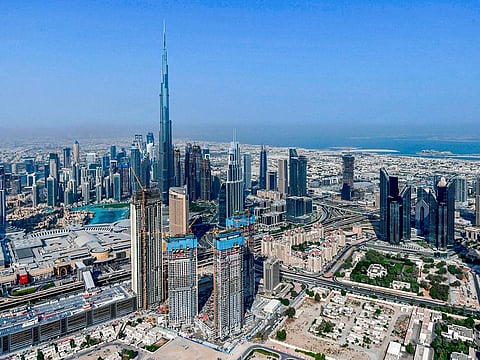UAE economy to grow 3.1 per cent in 2021, says the IIF
GCC countries face deepest recession in history, but are better off with large reserves

Dubai: The UAE’s economy is projected to turn around in 2021 with a 3.1 per cent GDP growth - after a 5.7 per cent contraction this year according to the Institute of International Finance (IIF). It expects a 5 per cent decline in average GDP growth of GCC countries this year, with the region's oil exporting countries facing an exceptionally challenging economic environment.
The plunge in oil prices and the associated restrictions associated with COVID-19 have led to deep recessions, widened fiscal deficits, shifted current account surpluses into sizable deficits, and increased financial stability risks. However, the major GCC oil exporters are better off given their large reserves.
“Saudi Arabia, the UAE, Kuwait, and Qatar enter this difficult environment from a position of strength, as shown by the large financial buffers (in the form of large official reserves and sovereign wealth funds)," said Garbis Iradian, Chief Economist MENA of the IIF. "These resources could be used in the coming years in the context of prolonged low oil prices to smooth out the needed adjustment to lower oil revenues.”
In addition to COVID-19, the economies were hit hard by the plunge in oil prices. The impact of the dual shocks is manifesting as the the worst recession in their history. While there are some indications that the virus outbreak in the region, excluding Iran, has successfully been contained, the depth of the contraction this year and the speed of the anticipated recovery in 2021 is subject to high uncertainty.
Saudi Arabia, the UAE, Kuwait, and Qatar enter this difficult environment from a position of strength, as shown by the large financial buffers. These resources could be used in the coming years in the context of prolonged low oil prices to smooth out the needed adjustment to lower oil revenues

Contraction and revival
The IIF said the UAE economy is expected to experience a deeper contraction this year than what was anticipated in May. “We expect a contraction of 5.7 per cent followed by a modest recovery of 3.1 per cent in 2021," said Iradian. "Dubai’s economy may contract by at least 8 per cent, more than Abu Dhabi, as its large exposure to tourism, aviation, and other services makes it more vulnerable to the effects of the pandemic.”
The PMI rose to 51 points in September, signaling a renewed expansion in the private sector. In June, the central bank injected Dh16 billion, equivalent to 1.2 per cent of GDP, in cash into the financial system to boost liquidity. While credit to the private sector declined by 1.5 per cent in July, credit to government-related-entities increased by 16.5 per cent, driven by various mega-projects.
Strong external position
The IIF has forecast the UAE’s external position to remain strong amid slow growth. The current account surplus, while narrowing, is forecast to remain sizable.
While foreign currency reserves managed by the central bank have declined by $10 billion to $96 billion in July, public foreign assets (official reserves plus SWFs) of the UAE exceed $800 billion (220 per cent of GDP). In the context of prolonged low oil prices, the UAE may need to pursue a gradual fiscal adjustment to balance the consolidated budget for the seven emirates and the federal government by 2023.
This could be achieved by mobilizing additional non-oil revenues, in the form of higher VAT, and cutting current spending, particularly public wages.
No immediate threat to GCC currency pegs
There is no significant pressure on the region’s currencies’ peg to the dollar. While GCC’s credit spreads are still wider than pre-COVID-19 levels, they are well below the average for emerging markets. “Market pressure on the pegged exchange rates appear to have abated. It is expected that the peg to the US dollar will be maintained at least for the next few years. Forward rates point to no change for local currencies,” said Iradian. The pegs to the dollar are underpinned by large foreign currency assets. Also, the flexibility of the labour market in the GCC allows for improving competitiveness without the need for currency adjustment.
Sign up for the Daily Briefing
Get the latest news and updates straight to your inbox







